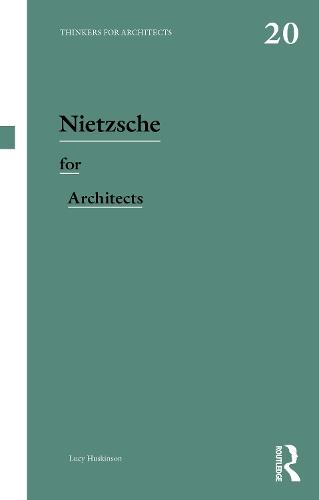Full Product Details
Author: Lucy Huskinson (University of Bangor, Wales, UK)
Publisher: Taylor & Francis Ltd
Imprint: Routledge
Weight: 0.430kg
ISBN: 9781032591773
ISBN 10: 1032591773
Pages: 132
Publication Date: 03 November 2025
Audience:
College/higher education
,
Professional and scholarly
,
Tertiary & Higher Education
,
Professional & Vocational
Format: Hardback
Publisher's Status: Active
Availability: Not yet available

This item is yet to be released. You can pre-order this item and we will dispatch it to you upon its release.
Reviews
""In this spirited, uplifting and assured book, Lucy Huskinson carefully and lucidly exposes Nietzsche's timely call to reanimate built form. As an invitation to 'listeners and seekers' to transcend functionalism and spent symbolism, it lifts architecture from its contemporary malaise, reviving it as a vital agent of cultural ambition and personal introspection. This book is a fascinating read and essential for all those who are designing and building for the future."" Dr. Martin Gledhill, architect, senior lecturer in architecture, University of Bath, UK, and author of The Bollingen Tower: Constructing a Jungian Sense of Place (Routledge, 2025) ""Architects will understand with Lucy Huskinson’s eloquent study that art is not a result of a flourishing culture, but its fundamental requirement. Only a completely unchained 'Will to Build' and a highly intense 'dance of design' can focus our imagination on 'an organic singleness of idea,' required by the architectural framework of life lived as a total art. By recognizing 'thinking as creating', our contemporary nihilistic culture, which is still fixated on ‘Being and Truth’ can open itself to the vast potentials of eternal human 'becoming' based on architecture understood as vigorous 'science of fiction'."" Stephen Griek, author of Nietzsches Architektur der Erkennenden. Die Welt als Wissenschaft und Fiktion (transcript: Bielefeld 2023) and lecturer of Philosophy of Architecture at Geneva's University of Applied Sciences and Arts (HEPIA), Switzerland
""In this spirited, uplifting and assured book, Lucy Huskinson carefully and lucidly exposes Nietzsche's timely call to reanimate built form. As an invitation to “listeners and seekers” to transcend functionalism and spent symbolism, it lifts architecture from its contemporary malaise, reviving it as a vital agent of cultural ambition and personal introspection. This book is a fascinating read and essential for all those who are designing and building for the future."" Dr. Martin Gledhill, architect, senior lecturer in architecture, University of Bath, and author of The Bollingen Tower: Constructing a Jungian Sense of Place (Routledge, 2025). ""Architects will understand with Lucy Huskinson’s eloquent study that art is not a result of a flourishing culture, but its fundamental requirement. Only a completely unchained “Will to Build” and a highly intense “dance of design” can focus our imagination on “an organic singleness of idea,” required by the architectural framework of life lived as a total art. By recognizing 'thinking as creating', our contemporary nihilistic culture, which is still fixated on ‘Being and Truth’ can open itself to the vast potentials of eternal human 'becoming' based on architecture understood as vigorous 'science of fiction'."" Stephen Griek, author of Nietzsches Architektur der Erkennenden. Die Welt als Wissenschaft und Fiktion (transcript: Bielefeld 2023) and lecturer of Philosophy of Architecture at Geneva's University of Applied Sciences and Arts (HEPIA)
Author Information
Lucy Huskinson is Professor of Philosophy at Bangor University, UK. Her interests lie in the intersections of philosophy, psychology, and architecture, and in the idea that buildings shape us as much as we shape them. She is author of several books in these fields, including Architecture and the Mimetic Self: A Psychoanalytic Study of How Buildings Make and Break Our Lives (2018) and Nietzsche and Architecture: The Grand Style for Modern Living (2024). Her books have been translated into Turkish, Serbian, and Portuguese.



